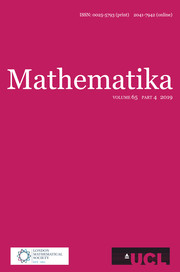Article contents
Rings which are residually ℤ
Published online by Cambridge University Press: 26 February 2010
Extract
Let  be a class of structures for a first-order language and let n be a positive integer. A structure A for the language is said to be n-residually
be a class of structures for a first-order language and let n be a positive integer. A structure A for the language is said to be n-residually  if, given elements a1, … an and b1, … bn of A with ai≠bi for 1 ≤i≤n, there exist B ∈
if, given elements a1, … an and b1, … bn of A with ai≠bi for 1 ≤i≤n, there exist B ∈  and an epimorphism φ:A → B such that φ(ai≠φ(bi for 1 ≤i ≤ n. We abbreviate 1 -residually
and an epimorphism φ:A → B such that φ(ai≠φ(bi for 1 ≤i ≤ n. We abbreviate 1 -residually  to residually
to residually  , and A is said to be fully residually
, and A is said to be fully residually  if it is n-residually for all n ≤ 1. We shall only be using two cases. One is where the language is the first-order language of groups, {·−1,1}, and A and all members of
if it is n-residually for all n ≤ 1. We shall only be using two cases. One is where the language is the first-order language of groups, {·−1,1}, and A and all members of  are groups. In this case we may take all the bi in the definition to be equal to 1. However, we are mainly interested in the first-order language of rings, {+,−·,0,1}. Again if A and all members of
are groups. In this case we may take all the bi in the definition to be equal to 1. However, we are mainly interested in the first-order language of rings, {+,−·,0,1}. Again if A and all members of  are rings, we may take all bi to be zero in the definition.
are rings, we may take all bi to be zero in the definition.
Information
- Type
- Research Article
- Information
- Copyright
- Copyright © University College London 1999
References
- 1
- Cited by

